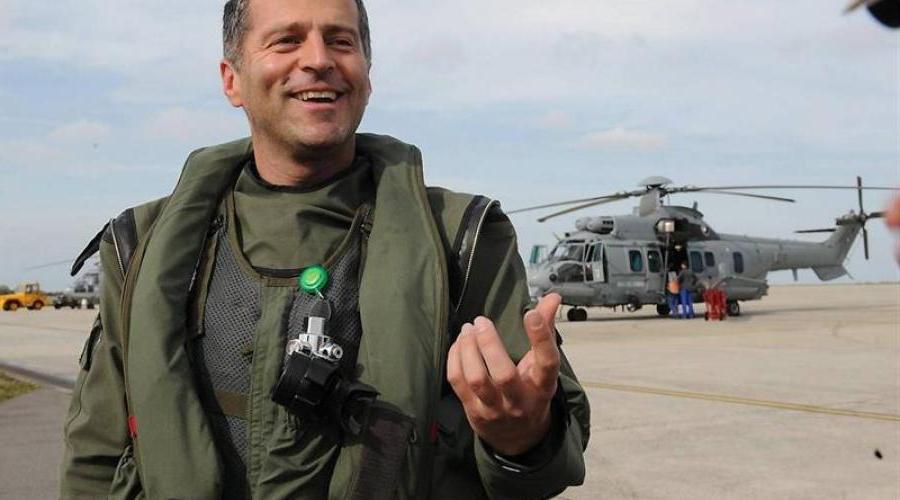Super Frelon



Category
Aerospace, Farnsworth, LeydeTertiary Intractions
Aerospace, Angola, Boston, Bretagne, China, Dassault, Defense, Egypt, France, Iran, Iraq, Leyde, Libya, Malta, Marignane, Namibia, South AfricaIn France, where it was designed, Super Frelon was replaced by other aircraft in primary missions for which it had been achieved. But this rugged and versatile device still used in many air forces and it career is not about to end.
In the field of aviation, the theory that a plane for successful cosmetic will necessarily be adapted to the task for which it was designed has often verified. This does not mean that an aircraft with little elegant lines not properly fulfill the missions that will be assigned to it. Such is the case of the super-frelon Aerospatiale SA321, which looks more like a transport helicopter to a machine for combat. Used in operational missions in the first line by several countries, including Libya, this aircraft can receive a nose in which is mounted radar.
The origins of super hornet back logically to the Hornet, produced by the French firm under the name SE3200. Made for use from land bases, the aircraft was characterized by a tail boom of unusual configuration, with its one-piece horizontal stabilizers and a four-bladed tail rotor. As for the main rotor, four-bladed he, too, was powered by three turboshaft Turbomeca Turmo IIIB, two of which were placed side by side in front of the rotor shaft, the third being mounted behind the tree.
Only two copies of SE3200 were assembled, the first of them performing its initial flight on June 10, 1959. In the meantime, Sud-est had been integrated into the Sud-aviation company, which launched the development of SA 3210 Super frelon to respond to requests from civil and military customers. The new helicopter was Calasetta inherited certain characteristics of the SE3200, including engine configuration, but take advantage of a more conventional tail boom, a main rotor blades to six and a tail rotor to five blades. Two prototypes and four and four pre series aircraft were made, the first of them flying 7 December 1962. The second prototype was to be used for the development of a navalized version with two stabilizing floats which were adopted on all series of models thereafter.
Failure on the civilian market
Attempts to impose the super frelon on civil market almost turned to disaster. Two aircraft (a SA321F and SA321J) were sold only the first of them being also employed by the Air Force for transport of persons between July 1970 and January 1971. The Army the air does not wish to equip the Super frelon aerospatiale became the first buyer of the aircraft. A contract for the delivery of 17 copies was signed in the month of December 1963, and the order was increased seven aircraft later. The French Army became interested for some time in super-frelon but she preferred to ultimately acquire the SA330 Puma aérospatiale.
The versions of anti underwater struggle and super-frelon transport are founded on the same cell and the same dynamic items. With a semi-bloc construction, the fuselage has watertight compartments below the cabin floor. The naval SA321G include a hydraulically foldable main rotor and tail boom also collapsible to facilitate storage on ships. Thanks to the latter system, the super-frelon length can be reduced from 23.03 to 17.07 m; in addition, the helicopter's landing gear shock absorbers can be compressed to reduce its height. Aircraft has a non-retractable tricycle lander, with two wheels on each leg.
The pilot and copilot take place in a dual control cabin and anti submarine missions, the super-frelon wins three sensor operators. The transport version can accommodate either 27 to 30 troopers, 15 lying wounded or sick and 2 medical assistants. It can carry a load of 5000 kg sling or in the cabin, and features on the right side of the fuselage of a winch with a capacity of 275 kg. The volume of freight that can be embedded in the car reaches 22 m³.
Turning between 207 and 212 rev / min, the main rotor is connected, through several boxes reducers, three Turmo turboshaft. The total power delivered by these devices was gradually increased. Featuring a maximum takeoff weight of 12,000 kg, the first series of aircrafts were indeed feature Turmo IIIC3 developing 1,100 kilowatts (1,475 hp). The establishment of Turmo IIIC6 1156 kW (1550 hp) and Turmo IIIC7 1201 kW (1610 hp) has increased the mass in question 1000 kg.
Operational equipment vary depending on the missions assigned to service machines. The main version of the Super-Frelon used by aeronavale is SA321Ga, five of which were produced for transport tasks and therefore have been provided with any means of detection. As for SA321Gh anti-submarine warfare, it was produced with a suitable navigation system with Doppler navigation and altimeter.
Originally, the order was aircraft equipped with an underwater sonar equipment and a tactical Sylph, the others being armed with weapons like what American MK46 torpedoes and guided french L5. The sensors Sylphe system - comprising an IFF - are placed in the domes covering a 360 ° sector and were mounted on all aircraft for service.
Anti-ship capability
In 1977, anti ships AM.39 Aerospatiale Exocet missiles were tested aboard Super frelon. Research and enlightenment goals are provided by a Omera segid-31D radar ORB Heracles 1 placed in a radar nose. The ORB 31D has a research capacity of 180 ° in azimuth and 30 ° in elevation and is able to detect a target in an area of 1000 m² at a distance of 80 km. The data collected by this equipment is directly transmitted to the missile before launch.
Some Super-frelon have received ORB 31D radar and the Sylph system, the latter having been replaced by fairings identical to those on the version of transport. No Super frelon from aeronavale was provided with the equipment ORB 32WAS Heracles 2, which seems to have been installed on the SA 321GM, delivered to Libya.
The Heracles 2, which has two antennas of 72 cm 36 mounted on the side floats, scans a hemisphere of 360 °. The Sylph system is also used, but it was set up in a nose much smaller than that of previous machines. The ORB 32WAS is used in the context of anti-submarine warfare for research, information concerning the tactical situation, missile guidance on the objectives, navigation and weather mapping. China's service SA321JA have military capabilities; in spite of their civil designation, these machines operate from platforms installed on board patrol buildings. Featuring behind ORB31D radars, three of these devices have labeled on an experimental basis, a new avionics including autopilot IDFS a Crouzet Nadir navigation system and radar Omera ORB32WAS associated with CSF Lamparo processors acoustic. Some of these facilities were mounted on Libyan super frelon. These devices feature two additional tanks mounted on each side of fuselage and can be modified to carry a sonar to immersion or a magnetometer sensor.
The super frelon in combat
The first Super-frelon used in combat were the SA321K acquired by the Israeli air force; the first copies ordered by the twelve Hebrew state had barely be delivered the Six Day War broke out in June 1967. These aircraft carried the troops to storm the airfield Sharm El Sheikh at the extremity of the Sinai peninsulendu. A decade later, Israeli think to equip their Super frelon turboshaft with General Electric T58-16 1413 kW (1895 hp) to improve performance in hot and high environment and equip them with the same propellants that Sikorsky CH53. These units were removed from service in the early 90s.
In South Africa, the SA3211 of Air force, devoid of floats were used for rescue missions and to transport VIP. They have also been used in support of ground units to fight against the blitz and may have participated in actions carried out in retaliation Angolan territory from Namibia, under the control of South Africans. The Super frelon was the only helicopter in service in South Africa that is capable of transporting armored vehicles Panhard AML, the Army uses in a large numbers. As Libyan, Israeli and Iraqi appliances, SA321L South Africans were provided with air intakes filters. These aircraft were withdrawn from service in 1992.
Deliveries of 16 super-frelon that China had ordered in the early seventies intervened between 1975 and 1977. Three of these machines were destroyed in accidents due to various causes. The devices of this type still airworthy regularly used on board ships of the Chinese navy equipped platforms.
Iraqi Super frelon feature the ORB31D radar and can carry air-to-surface Exocet missiles. Until October 1983, era of delivery to Iraq Dassault-Breguet Super Etendard equipped such missiles, the helicopters were the only platforms to carry an Iraqi Exocet available side.
Between September 1980, when the outbreak of war with Iran and in September 1983, Super-frelon vindicated the destruction of twenty-five buildings in Iranian waters. Oil platforms offshore were also damaged.
Libya has considered two versions of the super-frelon the first place to provided copies of SA321 being fitted with floats. Two of the machines, delivered in 1978, were deployed in Malta. They were removed from the island in 1980, when relations between Libya and Malta are cooled off. The information about other devices of this type are almost none, but it is almost certain that these last employed in the border conflict that pitted six day in Egypt and Libya in July 1977. If other SA321GM navalized would then be acquired by Libya.
The last super-frelon to leave the assembly lines of Aerospatiale in Marignane, was a SA321GM for Libya. One hundred and ten Super frelon, including prototypes had been built. A AS332 Super Puma navalized was offered to customers eager to possess anti submarine aircraft control and research and effective rescue. Specialists of aviation however, were very surprised when, in June 1986, China published photographs of their Changho Zhishengji, which is a copy of the Super-frelon. As reliable, Super-frelon is called to serve for many years still in the air forces and naval aeronautical who are equipped. Changes of naval electronic systems that are equipped. Changes of electronic systems will extend its effectiveness.
Primary intrication¹
- Super Frelon is built by Leyde
- Super Frelon is propulses by T58-16 1413 kW (1895 hp)
Secondary
- French army hold the very last Super Frelon in service in Bretagne
Tertiary
- Manhattan met Flottille 32F
- Sea Stallion is the main competitor
- General Electric belongs to Boston





